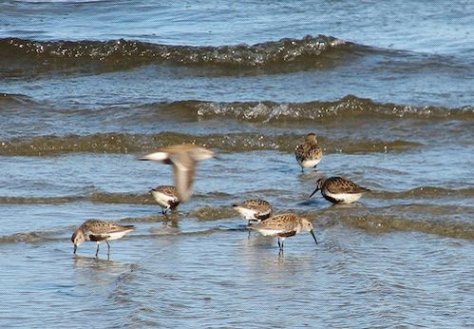Bird life in late summer
Text: Eet Tuule and Aarne Tuule, Tallinna Linnuklubi
Photo: Aarne Tuule
Translation: Liis
Foraging sandpipers.
High summer is slowly turning into late summer. It is a period when it seems to many that bird life has disappeared – the forests are silent, the waters nearly empty of birds. But in reality our winged friends haven’t vanished at all, they only go about their business quietly and unobtrusively. There is no particular reason for singing any longer: the nesting period is over and done with for this time. Some larger birds and second-time nesters may still be busy with caring for their young, but they are quite few. There are bird families that still stick together but the young already manage to fill their stomachs on their own. Only the young of some birds of prey are still learning the tricks of hunting, and for a very few this is still to come.
The young of the swifts don’t have that problem, they can fly at breakneck speed and catch insects on their own from their first wing-beats. And they manage that even if their too-impatient parents set course on Africa already before their young left the nest. Since the swifts are wholly birds of the air, their interesting and very complicated managing of their lives depends largely on weather conditions. So for instance, the better summer weather, the earlier they start their autumn migration. But so steadily favourable flying weather as this hot summer has provided takes some doing to remember. No wonder then that during the first week of August Tallinn has quietly been emptied of its last nesting swifts – only here and there a few small groups still circle over the nest areas.
But instead we can now meet migrants passing through here. Flocks of up to 400 birds from the north have been seen repeatedly in many areas. On July 28 a flock of 800 birds was observed over Paljassaar. The pipers, plovers, snipes and others just now busy at the same sea shore almost certainly belong to the foreigners too, because the autumn migration of pipers has been on, with varying intensity, for quite long already. Flock movements of yellow wagtails and wagtails have also started – the Paljassaare foreland at least was brimming with young wagtails on August 3. Four times fewer of them were tripping around in the same place on August 8, but instead there were five times as many chimney swallows.









